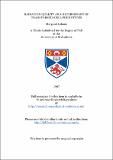Radiation quality as a determinant of transformed cell phenotypes
Abstract
Transformation is a complex multistage process in vitro by which benign cells gradually acquire characteristics of tumour cells. Transformed C3H10T1/2 cells appear in vitro as multilayers of cells termed foci. Two main aspects of transformation of C3H10T1/2 cells in vitro have been investigated. Firstly, the quantitative assessment of the dose and dose-rate effects after irradiation with 250 kVp X-rays were examined and secondly the relationship between various properties of transformed cells in vitro and their tumourigenic potential in vivo. The induction of transformation was found to be linear with dose for 0.25 to 5 Gy X-rays. Lowering the rate at which the X-ray dose is delivered to the C3H10T1/2 cells lowers the observed transformation frequency by at least a factor of two. A variety of transformed phenotypes are observed in vitro and samples of these phenotypes were developed as cell lines and assessed for a number of properties. These properties were the ability to induce tumours in C3H mice and the ability to reconstruct foci in vitro. Other properties examined were growth in vitro parameters (lag time, doubling time and saturation density) as well as chromosome number and distribution. Tumour cell lines were also developed and assessed for the above properties. Transformation phenotypes induced by X-rays and alpha-particles were compared. Differences were found between some of the properties of the X-ray and alpha- particle induced transformants. In particular, higher proportions of X-ray induced transformants were tumourigenic while most of the alpha-particle induced transformants were non-tumourigenic and also tumours induced by the X-ray induced transformants appeared earlier and grew faster than the alpha-particle induced equivalent. The ability of the transformation phenotypes to reconstruct foci in vitro was greater for alpha-particle induced transformants (not including tumour cell lines) than for the X-ray induced transformants. The reverse was true for tumour cells where X-rays produced higher frequencies of reconstructed foci than alpha-particles. No differences were noted in in vitro growth parameters irrespective of transformation phenotype or radiation type apart from differences in saturation density where the transformation phenotypes (not including tumour cells) generally produced higher densities than the tumour cells for both X-rays and alpha-particles. Chromosome numbers in cells of the different transformation phenotypes (including tumour cells) induced by both X-rays and alpha-particles showed a greater spread and a general shift of the mean and modal chromosome number to lower values than that of untransformed C3H10T1/2 cells. The presence of metacentric chromosomes (Robertsonian chromosomes) was not unique to the radiation induced transformation phenotypes as most of the cell lines examined showed fewer of these chromosomes than the untransformed cells. The X-ray induced transformants (including tumour cells) generally produced more Robertsonian chromosomes than the alpha-particle equivalent. Correlation tests of the above properties with tumourigenicity of the transformed cells revealed a positive correlation of tumourigenicity with the ability to reconstruct foci. A negative correlation was noted between the ability to reconstruct foci and the mean and modal chromosome numbers.
Type
Thesis, PhD Doctor of Philosophy
Collections
Items in the St Andrews Research Repository are protected by copyright, with all rights reserved, unless otherwise indicated.

